Understanding separation of powers and checks and balances is crucial for the AP United States Government and Politics exam. The separation of powers divides the government into three branches—Legislative, Executive, and Judicial—each with distinct functions and authority. Checks and balances ensure that no single branch becomes too powerful by allowing each branch to limit the powers of the others. This system maintains a balance of power, protects individual rights, and upholds democratic governance by preventing abuse of power.
Free AP United States Government and Politics Practice Test
Learning Objectives
For the topic of "Separation of Powers and Checks and Balances" in AP United States Government and Politics, you should learn about the distinct roles and powers of the Legislative, Executive, and Judicial branches of government and how they operate independently. Understand the mechanisms of checks and balances, including how each branch can limit the powers of the others. Analyze real-world examples of these principles in action, such as presidential vetoes, judicial reviews, and congressional overrides. Evaluate how these principles prevent abuse of power and protect democratic values. Finally, apply this knowledge to current events and governmental actions to see how they align with or challenge these constitutional frameworks.
The principle of separation of powers divides the U.S. government into three distinct branches: Legislative, Executive, and Judicial. Each branch has its own specific powers and responsibilities, preventing any one branch from holding too much power.
1. Legislative Branch (Congress)
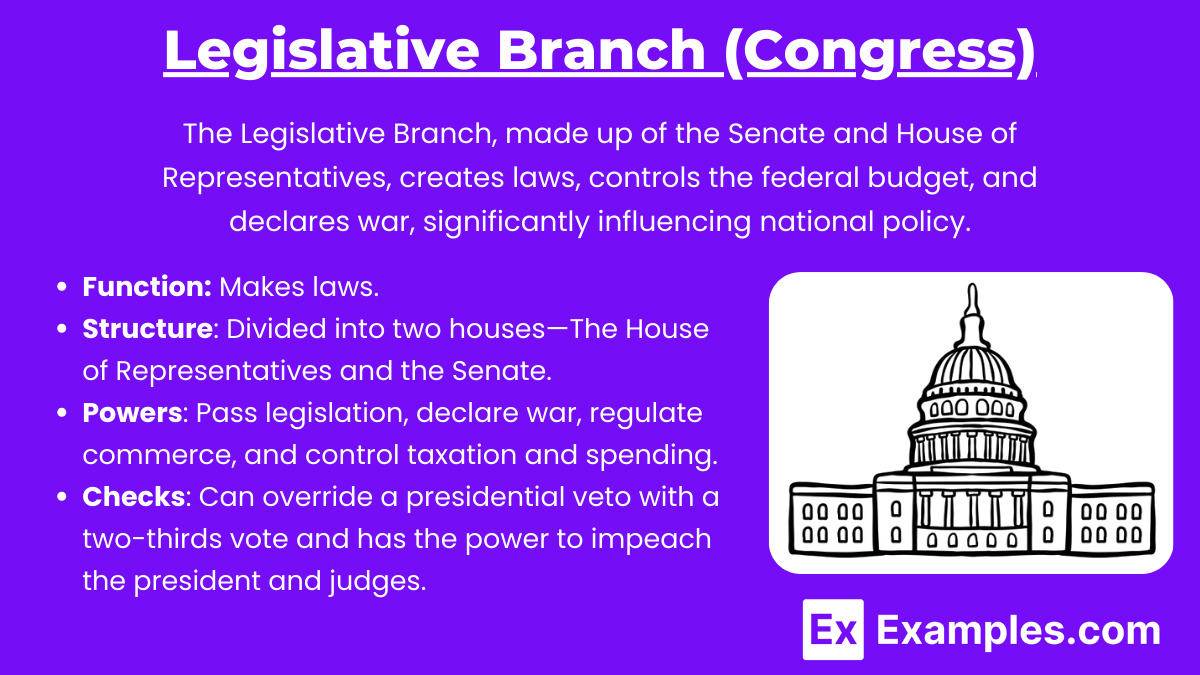
The Legislative Branch, consisting of the Senate and House of Representatives, creates laws, approves the federal budget, and holds the power to declare war. It plays a crucial role in shaping national policy.
Function: Makes laws.
Structure: Divided into two houses—The House of Representatives and the Senate.
Powers: Pass legislation, declare war, regulate commerce, and control taxation and spending.
Checks: Can override a presidential veto with a two-thirds vote and has the power to impeach the president and judges.
2. Executive Branch (President)
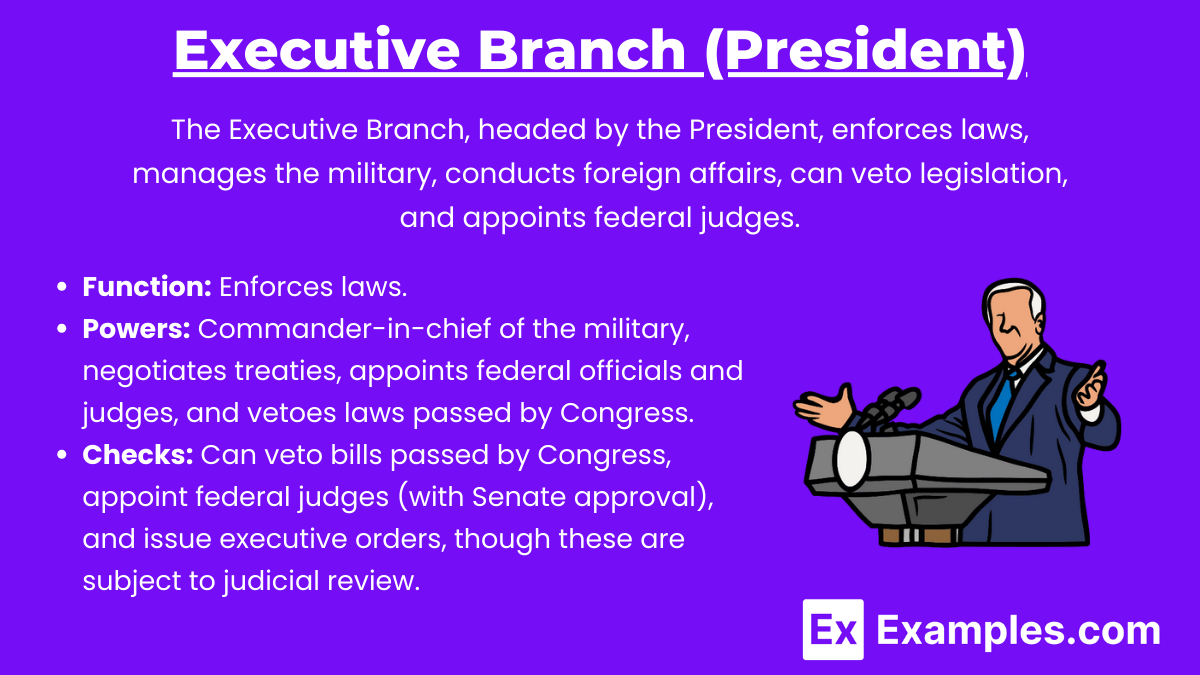
The Executive Branch, led by the President, enforces laws, oversees the military, conducts foreign relations, and has the authority to veto congressional legislation. It also appoints federal judges and issues executive orders.
Function: Enforces laws.
Powers: Commander-in-chief of the military, negotiates treaties, appoints federal officials and judges, and vetoes laws passed by Congress.
Checks: Can veto bills passed by Congress, appoint federal judges (with Senate approval), and issue executive orders, though these are subject to judicial review.
3. Judicial Branch (Supreme Court and lower federal courts)
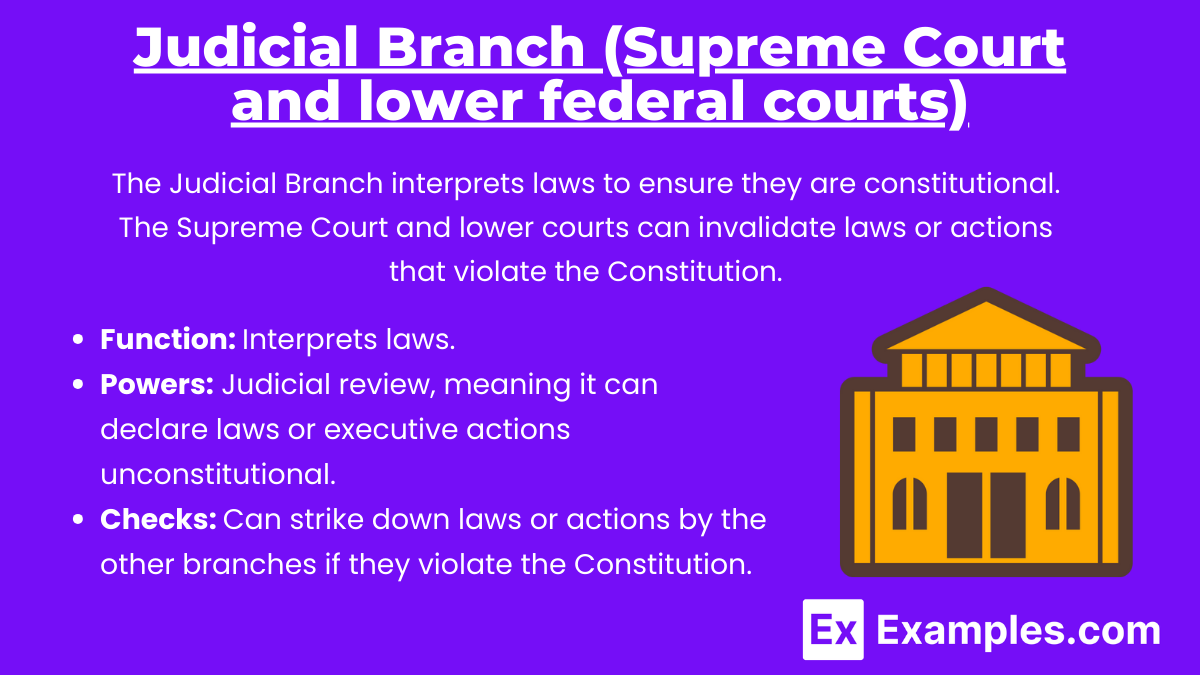
The Judicial Branch interprets laws and ensures they conform to the Constitution. The Supreme Court and lower federal courts have the power to review and nullify laws or executive actions deemed unconstitutional.
Function: Interprets laws.
Powers: Judicial review, meaning it can declare laws or executive actions unconstitutional.
Checks: Can strike down laws or actions by the other branches if they violate the Constitution.
Checks and Balances System
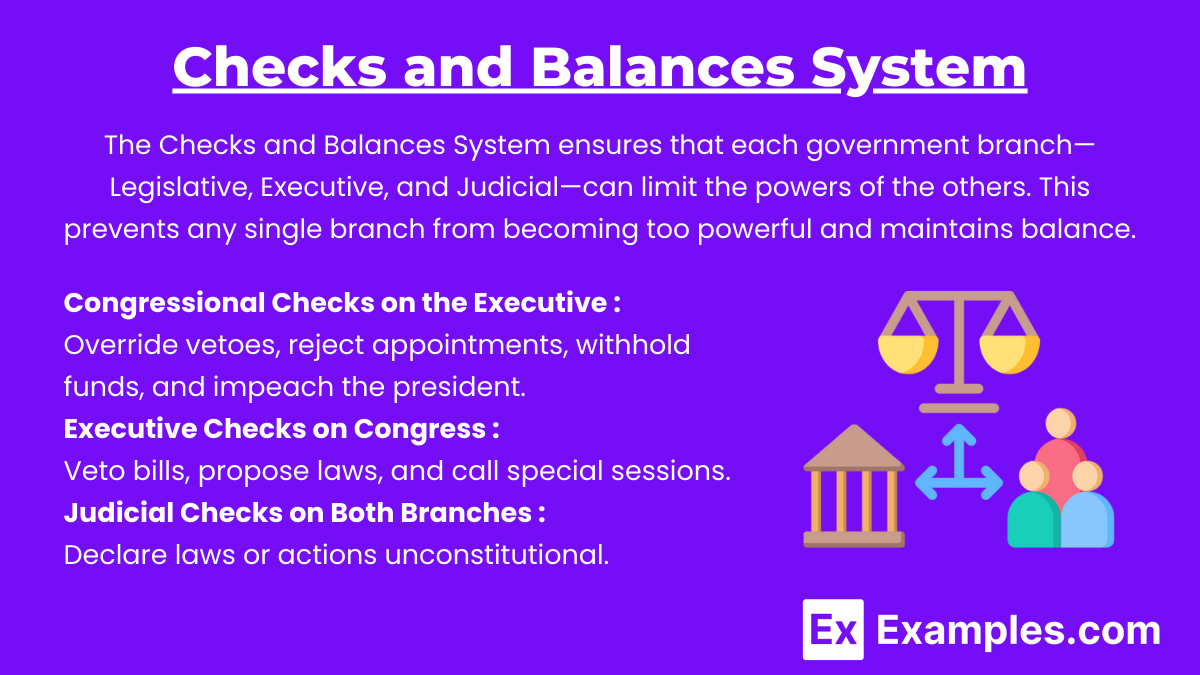
This system ensures that no branch becomes too powerful. Each branch has mechanisms to limit the actions of the other two, which encourages collaboration and limits abuses of power.
1. Congressional Checks on the Executive:
Congress can override a presidential veto, refuse to approve presidential appointments, or withhold funding. Additionally, Congress has the power to impeach and remove the president.
2. Executive Checks on Congress:
The president can veto bills passed by Congress, propose legislation, and call special sessions of Congress if necessary.
3. Judicial Checks on Both the Legislative and Executive Branches:
The Supreme Court can rule laws passed by Congress or actions by the president unconstitutional, ensuring laws and actions align with the Constitution.
4. Legislative Checks on the Judiciary:
Congress can propose constitutional amendments to overturn judicial decisions and must approve appointments of federal judges.
5. Executive Checks on the Judiciary:
The president appoints judges to the federal courts, including the Supreme Court, but these appointments require Senate approval.
Importance of Separation of Powers and Checks and Balances
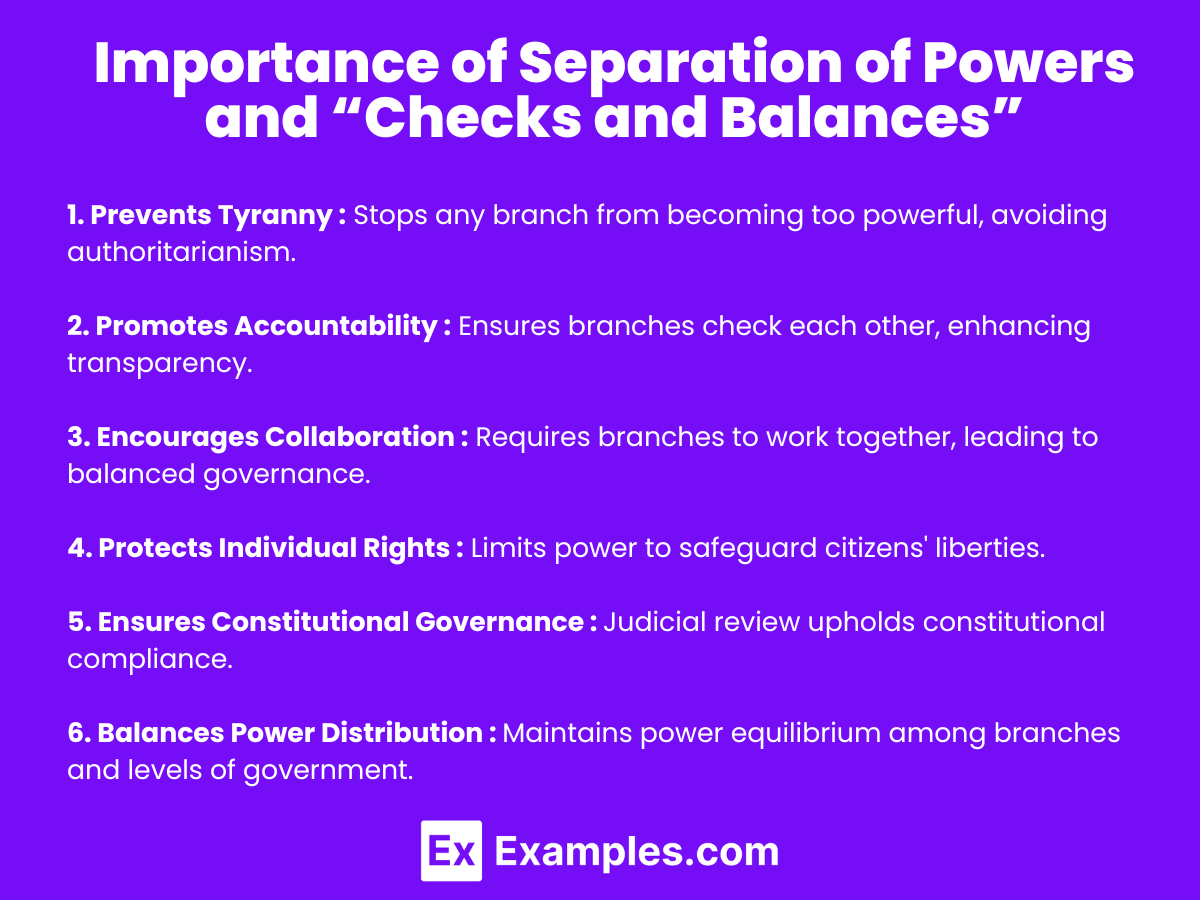
1. Prevents Tyranny
The separation of powers prevents any single branch of government from becoming too dominant, thereby protecting against the rise of authoritarian rule.
2. Promotes Accountability
Checks and balances ensure that each branch monitors and limits the actions of the others, promoting transparency and accountability in government.
3. Encourages Collaboration
The necessity for branches to cooperate on decisions fosters consensus and balanced governance, preventing unilateral actions.
4. Protects Individual Rights
By restricting the powers of each branch, the system guards against potential abuses and protects citizens' fundamental liberties.
5. Ensures Constitutional Governance
Judicial review allows courts to evaluate and ensure that laws and actions comply with the Constitution, maintaining constitutional integrity.
6. Balances Power Distribution
The system maintains a balance between different branches and levels of government, preventing any one entity from having unchecked power.
Examples
Example 1 : Presidential Veto
The President can veto legislation passed by Congress, preventing it from becoming law. Congress can override this veto with a two-thirds majority in both the House and Senate. This power balance ensures that no single branch, including the Executive, can unilaterally enact laws.
Example 2 : Judicial Review
The Supreme Court has the authority to review laws and executive actions to ensure they are constitutional. This power, established in Marbury v. Madison (1803), allows the Judicial branch to check the Legislative and Executive branches by invalidating laws or actions that violate the Constitution.
Example 3 : Congressional Oversight
Congress can conduct investigations and hold hearings to oversee the Executive branch’s implementation of laws and policies. This oversight ensures that the Executive branch acts within its legal bounds and is accountable to the Legislative branch.
Example 4 : Appointment and Confirmation
The President nominates federal judges, including Supreme Court justices, but these nominations must be confirmed by the Senate. This process ensures that the Executive branch’s judicial appointments are subject to scrutiny and approval by the Legislative branch.
Example : 5 Impeachment Power
Congress holds the power to impeach and remove the President and other federal officials from office. The House of Representatives can initiate impeachment proceedings, and the Senate conducts the trial to determine whether the official should be removed. This process checks the power of the Executive and other branches by holding them accountable for misconduct.
Multiple Choice Questions
Question 1
Which of the following actions demonstrates the principle of checks and balances?
a) The President issues an executive order.
b) Congress passes a law and the President vetoes it.
c) The Supreme Court makes a ruling on a legal case.
d) The Senate ratifies a treaty negotiated by the President.
Answer: b) Congress passes a law and the President vetoes it.
Explanation: This action illustrates checks and balances because it shows how the Executive branch (the President) can check the Legislative branch (Congress) by vetoing a law. Conversely, Congress can override the veto with a two-thirds majority, demonstrating the reciprocal power balance between branches.
Question 2
How does the Supreme Court exercise its power of judicial review?
a) By creating new laws.
b) By vetoing legislation passed by Congress.
c) By declaring laws unconstitutional.
d) By appointing federal judges.
Answer: c) By declaring laws unconstitutional.
Explanation: The Supreme Court exercises judicial review by evaluating whether laws or executive actions align with the Constitution. If a law or action is found unconstitutional, it is invalidated, which serves as a check on the Legislative and Executive branches.
Question 3
Which branch of government has the power to confirm or reject presidential appointments to the federal judiciary?
a) The Executive Branch
b) The Legislative Branch
c) The Judicial Branch
d) The State Governments
Answer: b) The Legislative Branch
Explanation: The Senate, part of the Legislative branch, has the authority to confirm or reject appointments made by the President to the federal judiciary. This process ensures that the Executive branch’s appointments are subject to oversight by the Legislative branch, balancing the power between these two branches.


